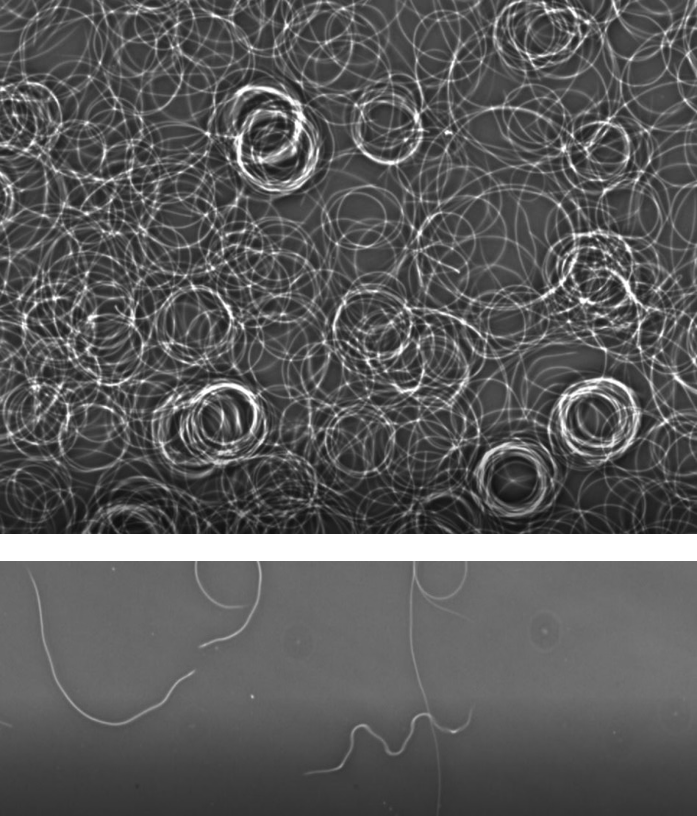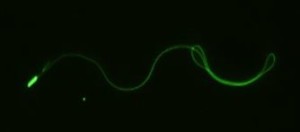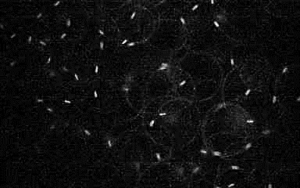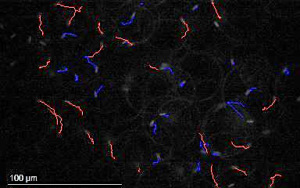We alluded in an earlier blog to the importance of bees as keystone species globally and provided some background on the reproduction of the African bee and our research on bee sperm. Sperm motility in all animals including insects is one of the most important parameters for measuring sperm quality. It is relatively easy to develop a manual scale for evaluating different grades of sperm motility but these have been shown to be subjective and prone to many errors. Accordingly, also in bee sperm and insect sperm at large there is a need to be able to quantify sperm motility using quantitative and objective methods such as CASA. The applications are numerous ranging from simple sperm quality assessment to toxicology to sperm competition.

Fig. 1: Above single and combined helical swimming patterns and below more progressive swimming sperm of African bee (negative phase contrast microscopy).
However, despite many efforts by many groups, to our knowledge no one has succeeded published/analysing bee sperm using fully automated CASA. The closest method used was a semi-quantitative CASA method (Murray, 2019). Why is it so difficult to measure CASA of bee and other insect sperm? There are three major challenges: the sperm tail is extremely long and in the bee about 225 µm compared to vertebrates where it ranges from about 40 to 75 µm; secondly the tails of many sperm are often heavily coiled in a helix and this complicates analysis; thirdly the head width is about the same as the tail width (so head centroid analysis impossible using traditional CASA by means of phase contrast methodology).
The typical swimming patterns of bee sperm is either in a helical form of single or combined sperm and what can be regarded as more progressive sperm (Fig. 1).
Modern CASA systems such as SCA (Microptic S.L, Barcelona) provides an option in the Motility Module to analyse sperm in the fluorescence mode. This method has been extensively used with great success in more sophisticated Andrology laboratories for human semen samples containing a lot of background particles (noise) as well as in the domestic animal market dealing with frozen-thawed bull sperm containing egg yolk particles. Accordingly, this methodology provides quantitative CASA analysis without interference of background particles since only the sperm heads fluoresce. Therefore, accurate sperm concentration and sperm motility can be measured.
There are fortunately fluorescence methods which involve vitality stains such as Sybr-14 which can be adapted for bee sperm. Using the FITC filter of a fluorescence microscope, the sperm head of live and motile bee sperm can be viewed (Fig. 2).

Fig. 2: Fluorescence microscopy of African bee sperm visualizing particulalrly the short sperm head (8 to 9 µm long) using Sybr-14 (Adapted from Murray, 2019).
All of this sounds very promising (head centroid movement can be performed) but there are three major hurdles to overcome. The width of the sperm head of insects is less than 1 µm and even if there are many sperm the fluorescence signal emanating from the sperm heads is very weak (low). Most of the current cameras used for CASA simply cannot analyse motile bee sperm heads at even minimal acceptable frame rates such as 25 fps since the fluorescence signal is very low (almost no bright enough image on screen). Yes, sperm head fluorescence (exposure) is sufficient to visualize and analyse at 1 to 5 fps but in terms of motility is of no value.
How have we solved the problem and made the breakthrough? It is a combination of many technical aspects of sperm concentration, medium used, concentration of Sybr 14, exposure time and many other aspects which will be published in the near future (Covid allowing). However, one of the most important aspects is that we used one of the new range Basler cameras specifically developed for fluorescence microscopy. Using one of these advanced cameras it was possible to perform motility of bee sperm at frame rates between 40 and 50 fps in fluorescence mode. Fig. 3 shows the sperm heads of motile sperm in grey level fluorescence and Fig. 4 the subsequent automatic analysis during about 0.5 to 1 second.


What are the motility percentages and kinematic parameters for bee sperm in the commonly used standard Kiev medium? The data is currently prepared for a peer-reviewed journal and the detailed base-line data can accordingly not be presented here. However, in more holistic terms the percentage progressive sperm motility ranged from approximately 20 to 60% and the Curvilinear Velocity (VCL) was low and ranged from about 20 to 90 µm/s. Improvement is required to make this a standard CASA technique for bee sperm but hopefully also for those insects with motile sperm.
Prof Gerhard van der Horst (PhD, PhD, Senior consultant to Microptic)
Ms Janice Murray (Hons. BSc) (MSc student at UWC – bee sperm research)
Dr Retha Kotze (PhD, Project leader on Insect sperm, Comparative Spermatology Laboratory (UWC), Bellville, South Africa)
[Reference: Murray, JF (2019). The developmental effect of maturity and unusual apiary rearing conditions on Cape honey bee drone spermatozoa. Honours B.Sc. dissertation, Department of Medical Bioscience, University of the Western Cape, Bellville, South Africa]